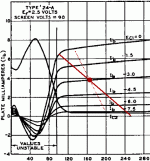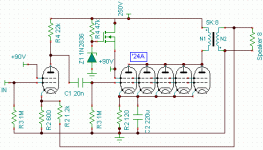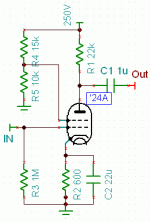It is the first AC-heat tetrode: two key innovations in one.
Tetrodes make awful amplifiers. Pentodes displaced tetrodes so fast it wasn't funny. (So-called Beam Tetrodes are pentodes. Details are different to avoid patent fights, but the electrons go through the same fields as a pentode.)
It is a small tetrode: no good for power. Maybe headphones.
It eats a lot of heater power for what it does. Heater-cathode insulation isn't that good.
It may be low distortion (if you stay out of the kinky-zone).
It does not seem to be at all rare: $5 many places.
It is a very pretty tube.
http://frank.pocnet.net/sheets/029/2/24A.pdf
The grid bias could be a 1K8 cathode resistor. Output impedance would be the plate resistor, too high to run outside the box.
Looking at the plate-curves, another operating point could be: Plate supply 250V, grid voltage -3V (or 600 ohm cathode resistor), screen supply 90V, plate current 4mA, plate load resistor 22K. With cathode bypass, this gives gain around 25 and output impedance of 22K.
Screen grid voltage has to be stable: either a voltage-divider with several mA of current flowing, another winding on the power transformer, or regulated.
It should work as a triode (screen strapped to plate) but I can not find any data for this condition.
Tetrodes make awful amplifiers. Pentodes displaced tetrodes so fast it wasn't funny. (So-called Beam Tetrodes are pentodes. Details are different to avoid patent fights, but the electrons go through the same fields as a pentode.)
It is a small tetrode: no good for power. Maybe headphones.
It eats a lot of heater power for what it does. Heater-cathode insulation isn't that good.
It may be low distortion (if you stay out of the kinky-zone).
It does not seem to be at all rare: $5 many places.
It is a very pretty tube.
http://frank.pocnet.net/sheets/029/2/24A.pdf
An externally hosted image should be here but it was not working when we last tested it.
The grid bias could be a 1K8 cathode resistor. Output impedance would be the plate resistor, too high to run outside the box.
Looking at the plate-curves, another operating point could be: Plate supply 250V, grid voltage -3V (or 600 ohm cathode resistor), screen supply 90V, plate current 4mA, plate load resistor 22K. With cathode bypass, this gives gain around 25 and output impedance of 22K.
Screen grid voltage has to be stable: either a voltage-divider with several mA of current flowing, another winding on the power transformer, or regulated.
It should work as a triode (screen strapped to plate) but I can not find any data for this condition.
yes it is easy to buy but not easy to find anyone use it?
looks realy nice one so I want to design an amp with it. maybe triode connect is a good idea but I have no idea to make sure the plate load plate votage Vg1 even the cath resist...... If i use it as tetrode it have some stability problems. so the pure tetrode was soon superseded.(from valve amplifiers p88) according to this book the 24A is not good in audio amp? how could i do with these tubes?
looks realy nice one so I want to design an amp with it. maybe triode connect is a good idea but I have no idea to make sure the plate load plate votage Vg1 even the cath resist...... If i use it as tetrode it have some stability problems. so the pure tetrode was soon superseded.(from valve amplifiers p88) according to this book the 24A is not good in audio amp? how could i do with these tubes?
> I have no idea to make sure the plate load plate votage Vg1 even the cath resist...... If i use it as tetrode it have some stability problems.
Nah. You just have to stay away from low plate voltages.
This should work as a line-amp:
The dynamic loadline is about like this:
Nah. You just have to stay away from low plate voltages.
This should work as a line-amp:
An externally hosted image should be here but it was not working when we last tested it.
The dynamic loadline is about like this:
An externally hosted image should be here but it was not working when we last tested it.
This should probably work as a "power amp", around 1 Watt with some damping:
For Stereo: This needs a 2.5V 21 Amp heater supply, and about 50mA at 250V. And a dozen type '24 bottles, which isn't really a lot of cash (maybe $60-$75) compared to type '50, 2A3, and other old-reliables that have become fashionable.
In general: using "modern" triodes and pentodes, I could do what a '24 does but using 2/3rd the plate power and 1/4 the heater power. As a practical commercial matter: if this were 1928 all over again, I could make a good radio a lot cheaper with later tubes. However the world has turned topsy-turvy since 1928. We have reached the heights of high-efficiency 200-watt 8417 tube-amps, and have turned aside to low-efficiency pretty-bottle amps.
An externally hosted image should be here but it was not working when we last tested it.
For Stereo: This needs a 2.5V 21 Amp heater supply, and about 50mA at 250V. And a dozen type '24 bottles, which isn't really a lot of cash (maybe $60-$75) compared to type '50, 2A3, and other old-reliables that have become fashionable.
In general: using "modern" triodes and pentodes, I could do what a '24 does but using 2/3rd the plate power and 1/4 the heater power. As a practical commercial matter: if this were 1928 all over again, I could make a good radio a lot cheaper with later tubes. However the world has turned topsy-turvy since 1928. We have reached the heights of high-efficiency 200-watt 8417 tube-amps, and have turned aside to low-efficiency pretty-bottle amps.
Hmmmmm... I'm going to take a flying leap through a rolling grid-cap and guess that a triode-strapped '24 might be a lot like a '27 triode. It seems a '24 has a higher Mu than a '27, which makes some sense: the '24 is for large voltage gain into very high impedance, the -27 was used for modest voltage gain into moderate impedances.
If you have a heap of '24s looking for a good home, you may as well strap them into semi-'27s. Triode-strapping the pure-tetrode eliminates the wonky behavior at low plate voltages. And saves the awkwardness of a low-impedance lower-voltage screen supply.
This should cook over 1 Watt with excellent linearity. You could omit the 1.2K feedback resistor and be zero global feedback. OPT current is about 25mA. Going to a 10K load will reduce distortion and improve damping more than it hurts power.
The first stage alone might be a good line-amp. Gain about 5 or 10, output impedance around 10K.
If you actually stick a dozen '24s on a box, I want a picture. In the light, and in the dark.
If you have a heap of '24s looking for a good home, you may as well strap them into semi-'27s. Triode-strapping the pure-tetrode eliminates the wonky behavior at low plate voltages. And saves the awkwardness of a low-impedance lower-voltage screen supply.
This should cook over 1 Watt with excellent linearity. You could omit the 1.2K feedback resistor and be zero global feedback. OPT current is about 25mA. Going to a 10K load will reduce distortion and improve damping more than it hurts power.
An externally hosted image should be here but it was not working when we last tested it.
The first stage alone might be a good line-amp. Gain about 5 or 10, output impedance around 10K.
If you actually stick a dozen '24s on a box, I want a picture. In the light, and in the dark.
Resurrecting this old thread
I spotted this article on 6moons:
6moons audioreviews: JohnBlue Audio Art JB3 Sidebar I
it seems 24a is really good when using for preamp.
Incidentally I have a bunch of them...
Can everybody suggest other scheme?
Anyone tried the triode-strapped preamp described above (i.e. the first part of the last power amp scheme)?
Ciao
I spotted this article on 6moons:
6moons audioreviews: JohnBlue Audio Art JB3 Sidebar I
it seems 24a is really good when using for preamp.
Incidentally I have a bunch of them...
Can everybody suggest other scheme?
Anyone tried the triode-strapped preamp described above (i.e. the first part of the last power amp scheme)?
Ciao
Hmmmmm... I'm going to take a flying leap through a rolling grid-cap and guess that a triode-strapped '24 might be a lot like a '27 triode. It seems a '24 has a higher Mu than a '27, which makes some sense: the '24 is for large voltage gain into very high impedance, the -27 was used for modest voltage gain into moderate impedances.
If you have a heap of '24s looking for a good home, you may as well strap them into semi-'27s. Triode-strapping the pure-tetrode eliminates the wonky behavior at low plate voltages. And saves the awkwardness of a low-impedance lower-voltage screen supply.
This should cook over 1 Watt with excellent linearity. You could omit the 1.2K feedback resistor and be zero global feedback. OPT current is about 25mA. Going to a 10K load will reduce distortion and improve damping more than it hurts power.
An externally hosted image should be here but it was not working when we last tested it.
The first stage alone might be a good line-amp. Gain about 5 or 10, output impedance around 10K.
If you actually stick a dozen '24s on a box, I want a picture. In the light, and in the dark.
PRR,
pics are no longer visible!
Please, can you post them again as I'd like to build the preamp you suggested?
Thank you for your help!
> pics are no longer visible!
It's been nearly a decade. The world moves on.
I did dig in my backups.
Thank you VERY much PRR, hope you'll rewarded soon by some pics of your work as requested 10 years ago!
PS: As for valve stuff the world doest't move on, it actually turns round
Ciao!
> pics are no longer visible!
It's been nearly a decade. The world moves on.
I did dig in my backups.
PS: Do you still have the triode strapped preamp version too? That was my target!
PS: Do you still have the triode strapped preamp version too? That was my target!
Pheraps it was a stupid question, and maybe it's enought to connet grid to anode and then the rest is exactly the same...
Is it ok?
Thank you!
Hi,
I am newly joined to the forum. I have just finished a 24A power amp. 13 tubes (including rectifier)
I have not done any critical listening but from what I can tell, at least a nice a sound than the Darling, a little more power too. 20 amps of filament current! I needed two transformers, one for each side. I used a simple C-L-C filter on B+, no hum. This is a real benefit of heater-cathode tubes. I will post pictures soon.
I am newly joined to the forum. I have just finished a 24A power amp. 13 tubes (including rectifier)
I have not done any critical listening but from what I can tell, at least a nice a sound than the Darling, a little more power too. 20 amps of filament current! I needed two transformers, one for each side. I used a simple C-L-C filter on B+, no hum. This is a real benefit of heater-cathode tubes. I will post pictures soon.
Hi,
I am newly joined to the forum. I have just finished a 24A power amp. 13 tubes (including rectifier)
I have not done any critical listening but from what I can tell, at least a nice a sound than the Darling, a little more power too. 20 amps of filament current! I needed two transformers, one for each side. I used a simple C-L-C filter on B+, no hum. This is a real benefit of heater-cathode tubes. I will post pictures soon.
Please, post some pics too!
It should be a real beauty!
- Status
- This old topic is closed. If you want to reopen this topic, contact a moderator using the "Report Post" button.
- Home
- Amplifiers
- Tubes / Valves
- could 24A been power tube




